Medieval History
In my last post I excused my absence from blogging, I've been quite busy in the parish over the last few weeks. I've been particularly occupied with arrangements for the solemn Eucharist for Candlemas that was held in the glorious surroundings of Stow Minster. I've been putting off posting about Stow Minster, but having given you that tantalising glimpse of this building, I thought I might say a bit more about the place.
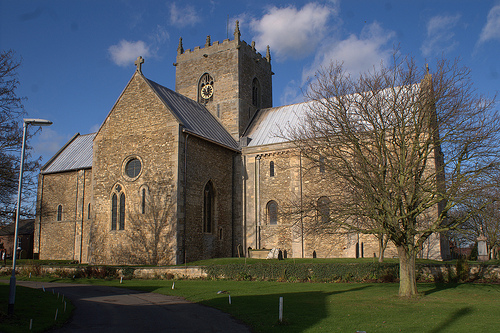
Stow Minster, the parish church of St Mary the Virgin of Stow, is an extremely important building. It's a building that dominates the small village to the north of Lincoln that surrounds it - in fact it dominates the whole countryside around it. The name Stow means 'holy place' and the village was an important centre for christian mission and worship from the Anglo-Saxon period. Stow was so important in former times that many of the villages around it have 'by Stow' added to their place names - Coates by Stow, Sturton by Stow, Willingham by Stow, Normanby by Stow.
By tradition the first church on this site was built in the late seventh century at a spot where St Etheldreda rested for a time while on a journey. The legend is that she planted her walking stick in the ground and it blossomed into a tree and in due course the church was built beside it. Stow is often identified as Sidnacaester, the cathedral of the Anglo-Saxon diocese of Lindsey, but that identification is possible, but sadly unprovable.
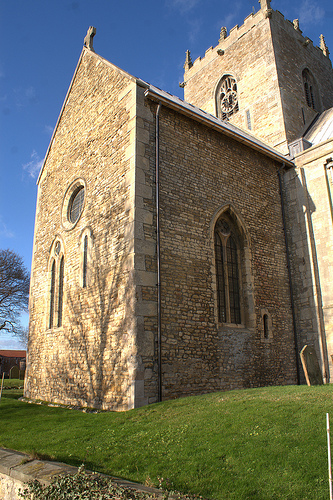

The monumental round arches of the central crossing probably date from Eadnoth's episcopate.
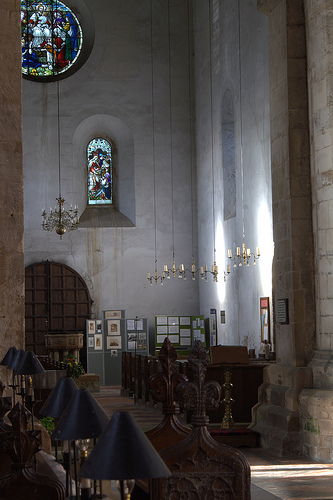
The priory was to be short-lived, the monks were quickly moved back south by Remigius' sucessor, bishop Robert Bloet and Stow minster became a parish church, which it remains. The endownment was transferred to two prebendal stalls in Lincoln cathedral.
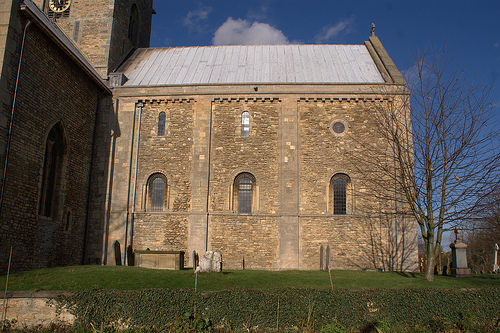
That's not the end of the story. The bishops of Lincoln owned a manor in Stow and they established a palace there. The palace of Stow Park was a favourite country retreat of sucessive bishops, including bishop Hugh of Avalon, St Hugh. It was at Stow that St Hugh made friends with the swan that was to become his attribute. The bishops of Lincoln continued to lavish money on Stow Minster, and at some point towards the end of the twelfth century, perhaps even during Hugh's tenure, they rebuilt the present chancel of the parish church.

Very little has been added to the building since. The central tower was rebuilt in the fifteenth century and strengthened with new arches set within the Saxon arches. Perpendicular windows were inserted into the east and west ends, but little else was done to the structure.
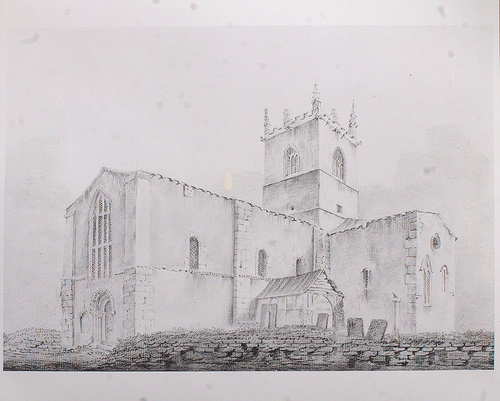
By the early nineteenth century the building had become seriously dilapidated, and in the 1850s and 60s it was restored under the direction of J L Pearson, who removed some of the later accretions including the Perpendicular windows. In the chancel, the first part of his restoration he inserted a rib vault in place of the late medieval timber ceiling.
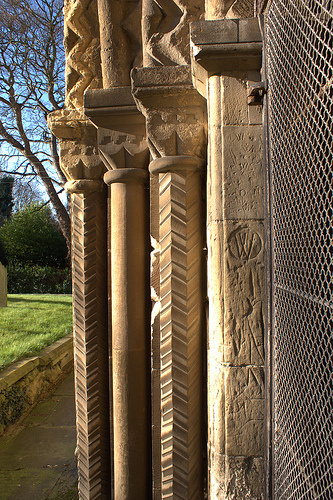
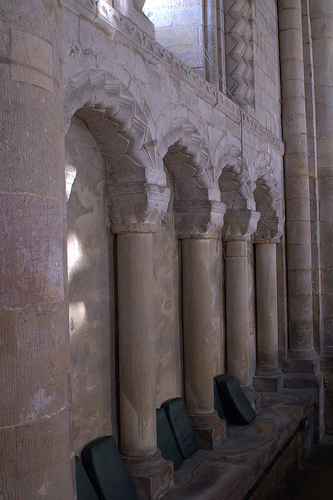
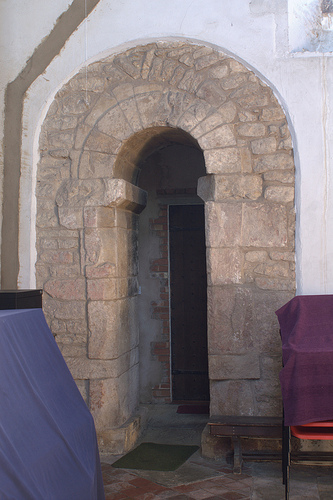
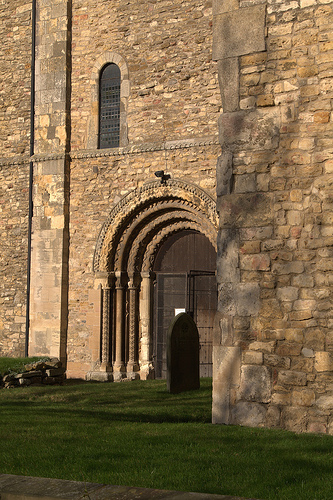

Sadly the future of this important and venerable building is at considerable risk. The Pearson restoration has come to the end of its natural life and now considerable work needs to be done to the building both internally and externally. The small and devoted congregation have already managed to raise sufficient money to repair the transept roofs, but the great roofs of the nave and chancel now need urgent attention. The full cost of this work is around three million pounds, far more than the tiny parish are capable of raising. So what will happen? Well one very real possibility is that this building of national importance, will cease to be a parish church and that the long tradition of christian witness and worship in this place will be lost. A very sad future for a glorious and inspiring building that simply comes alive when used as it was intended, for the Eucharist.
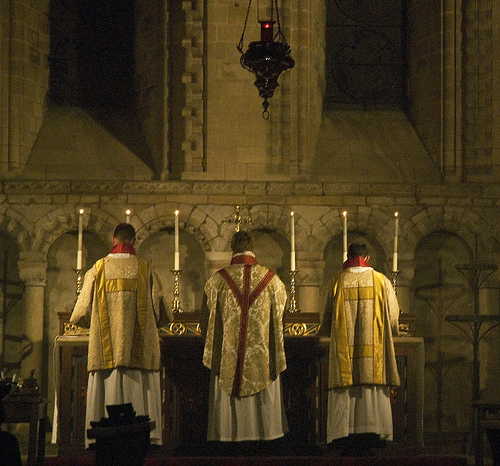
- Briefly Noted -- Accessus: A Journal Of Premodern Literature And New Media
Readers of Modern Medieval will want to go take a look at the inaugural issue of Accessus, a publication of the Gower Project. This excellent-looking first issue includes the following essays that bring together disability studies, medieval studies, manuscript...
- Malvern Link
I'm grateful to a Facebook friend Julie Allsopp, who has recently taken the following photos of the once glorious conventual chapel of the Holy Name at Malvern Link in Worcestershire. This chapel, dating from...
- Beware The Ides Of March
The Norman chancel arch at Glympton in Oxfordshire has the following interesting and tantalising inscription carved on its jamb: 'Dedicatio hujus templi Idus Martii' i.e. 'this temple was dedicated on the Ides (15th) of...
- Absence
Stow Candlemas Eucharist, originally uploaded by gordonplumb.My absence is due in the most part to busyness in the parish. One of the things I've been working on is the liturgy for a solemn Eucharist for Candlemas. This took place in the glorious...
- Time Stood Still...
... at Coates-by-Stow in Lincolnshire. The church of St Edith Coates-by-Stow appears to have avoided the notice of the sixteenth century reformers and has preserved it's pre-Reformation fittings more-or-less intact. It's in a fairly isolated...
Medieval History
More on Stow
In my last post I excused my absence from blogging, I've been quite busy in the parish over the last few weeks. I've been particularly occupied with arrangements for the solemn Eucharist for Candlemas that was held in the glorious surroundings of Stow Minster. I've been putting off posting about Stow Minster, but having given you that tantalising glimpse of this building, I thought I might say a bit more about the place.

Stow Minster, the parish church of St Mary the Virgin of Stow, is an extremely important building. It's a building that dominates the small village to the north of Lincoln that surrounds it - in fact it dominates the whole countryside around it. The name Stow means 'holy place' and the village was an important centre for christian mission and worship from the Anglo-Saxon period. Stow was so important in former times that many of the villages around it have 'by Stow' added to their place names - Coates by Stow, Sturton by Stow, Willingham by Stow, Normanby by Stow.
By tradition the first church on this site was built in the late seventh century at a spot where St Etheldreda rested for a time while on a journey. The legend is that she planted her walking stick in the ground and it blossomed into a tree and in due course the church was built beside it. Stow is often identified as Sidnacaester, the cathedral of the Anglo-Saxon diocese of Lindsey, but that identification is possible, but sadly unprovable.

What we do know, is that by the tenth and eleventh century there was already a major church building, of the present proportions, on this site. In the last quarter of the tenth century, Bishop Aelfnoth of Dorchester is believed to have constructed a substantial church building to serve as a Minster for the northern part of his vast diocese. The earliest parts of the present structure, the walls of the transepts, were probably part of that building or of work completed in the early eleventh century. In the twenty years before the Norman Conquest bishop Eadnoth II did some further work to the church, with the finanical assistance of Leofric Earl of Mercia and his wife Lady Godiva. In 1054 Eadnoth raised this new church to be a Minster of secular canons and endowed it with property. His intention being to establish it as a base from which he could oversee the northern part of his vast diocese.

The monumental round arches of the central crossing probably date from Eadnoth's episcopate.
In 1073 bishop Remigius of Dorchester, moved his see to Lincoln and Stow ceased to be an important administrative centre and the minster foundation probably failed. However the religious life of Stow was revived by Remigius, who moved Benedictine monks from Eynsham in Oxfordshire to Stow, to establish a priory. As part of that work he constructed the present nave.

The priory was to be short-lived, the monks were quickly moved back south by Remigius' sucessor, bishop Robert Bloet and Stow minster became a parish church, which it remains. The endownment was transferred to two prebendal stalls in Lincoln cathedral.

That's not the end of the story. The bishops of Lincoln owned a manor in Stow and they established a palace there. The palace of Stow Park was a favourite country retreat of sucessive bishops, including bishop Hugh of Avalon, St Hugh. It was at Stow that St Hugh made friends with the swan that was to become his attribute. The bishops of Lincoln continued to lavish money on Stow Minster, and at some point towards the end of the twelfth century, perhaps even during Hugh's tenure, they rebuilt the present chancel of the parish church.

Very little has been added to the building since. The central tower was rebuilt in the fifteenth century and strengthened with new arches set within the Saxon arches. Perpendicular windows were inserted into the east and west ends, but little else was done to the structure.

By the early nineteenth century the building had become seriously dilapidated, and in the 1850s and 60s it was restored under the direction of J L Pearson, who removed some of the later accretions including the Perpendicular windows. In the chancel, the first part of his restoration he inserted a rib vault in place of the late medieval timber ceiling.





Sadly the future of this important and venerable building is at considerable risk. The Pearson restoration has come to the end of its natural life and now considerable work needs to be done to the building both internally and externally. The small and devoted congregation have already managed to raise sufficient money to repair the transept roofs, but the great roofs of the nave and chancel now need urgent attention. The full cost of this work is around three million pounds, far more than the tiny parish are capable of raising. So what will happen? Well one very real possibility is that this building of national importance, will cease to be a parish church and that the long tradition of christian witness and worship in this place will be lost. A very sad future for a glorious and inspiring building that simply comes alive when used as it was intended, for the Eucharist.

- Briefly Noted -- Accessus: A Journal Of Premodern Literature And New Media
Readers of Modern Medieval will want to go take a look at the inaugural issue of Accessus, a publication of the Gower Project. This excellent-looking first issue includes the following essays that bring together disability studies, medieval studies, manuscript...
- Malvern Link
I'm grateful to a Facebook friend Julie Allsopp, who has recently taken the following photos of the once glorious conventual chapel of the Holy Name at Malvern Link in Worcestershire. This chapel, dating from...
- Beware The Ides Of March
The Norman chancel arch at Glympton in Oxfordshire has the following interesting and tantalising inscription carved on its jamb: 'Dedicatio hujus templi Idus Martii' i.e. 'this temple was dedicated on the Ides (15th) of...
- Absence
Stow Candlemas Eucharist, originally uploaded by gordonplumb.My absence is due in the most part to busyness in the parish. One of the things I've been working on is the liturgy for a solemn Eucharist for Candlemas. This took place in the glorious...
- Time Stood Still...
... at Coates-by-Stow in Lincolnshire. The church of St Edith Coates-by-Stow appears to have avoided the notice of the sixteenth century reformers and has preserved it's pre-Reformation fittings more-or-less intact. It's in a fairly isolated...
